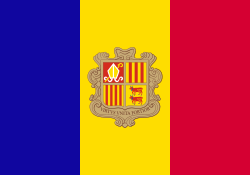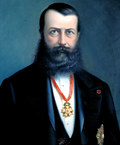Andorra
Andorra (/ænˈdɒrə/ (![]() listen)), officially the Principality of Andorra, is a landlocked sovereign country located in the eastern Pyrenees Mountains of Southern Europe and bordered by Spain and France.[14]
listen)), officially the Principality of Andorra, is a landlocked sovereign country located in the eastern Pyrenees Mountains of Southern Europe and bordered by Spain and France.[14]
Principality of Andorra[1] | |
|---|---|
| Motto: | |
| Anthem: | |
![Location of Andorra (centre of green circle) on the European continent (dark grey) — [Legend]](https://upload.wikimedia.org/wikipedia/commons/thumb/1/12/Location_Andorra_Europe.png/500px-Location_Andorra_Europe.png) Location of Andorra (centre of green circle) on the European continent (dark grey) — [Legend] | |
| Capital and largest city | Andorra la Vella 42°30′N 1°31′E / 42.500°N 1.517°ECoordinates: 42°30′N 1°31′E / 42.500°N 1.517°E |
| Official languages | Catalan[1]b |
| Ethnic groups (2017) |
|
| Religion | Roman Catholicism[4][5] |
| Demonym(s) | Andorran |
| Government | Unitary parliamentary semi-elective diarchy |
| Xavier Espot Zamora | |
| Roser Suñé Pascuet | |
| Legislature | General Council |
| Independence | |
• from Aragon | 8 September 1278[6][7] |
• from the French Empire | 1814 |
| 2 February 1993 | |
| Area | |
• Total | 467.63 km2 (180.55 sq mi) (178th) |
• Water (%) | 0.26 (121.4 ha)c |
| Population | |
• 2020 estimate | |
• Density | 179.8/km2 (465.7/sq mi) (71st) |
| GDP (nominal) | 2018 estimate |
• Total | $3.237 billion[9] |
• Per capita | $42,035 |
| Gini (2003) | 27.21d low |
| HDI (2019) | very high · 36th |
| Currency | Euro (€)e (EUR) |
| Time zone | UTC+01 (CET) |
• Summer (DST) | UTC+02 (CEST) |
| Driving side | right[11] |
| Calling code | +376 |
| ISO 3166 code | AD |
| Internet TLD | .adf |
| |
Overview
There are about 79,000 people living in Andorra. The capital is Andorra la Vella. It is ruled by a Spanish Bishop and the French President, who hold the title of Co-Prince together. Andorra's government is a parliamentary democracy.
Andorra is a rich country mostly because of tourism. There are about 10.2 million visitors each year.[15] The official language is Catalan, though Spanish and French are also used. The Euro (EUR) is the currency of Andorra, though it is not a member of the European Union (EU).
History
It is said that emperor Charlemagne gifted the Andorran people their country in the 9th century for fighting against the Moors. Before AD 1095, Andorra was not militarily protected. The Lord of Caboet and the Bishop of Urgell decided to rule Andorra together. Andorra's first legislature was created in AD 1419.
The descendants of the Lord of Caboet eventually became the Kings of France over time. When France became a republic, the French King's position as the Co-Prince was taken up by the President of France.
Andorra declared war on Imperial Germany in World War I, but did not do any fighting. Andorra remained in a state of war against Germany until 1957 as the Andorrans did not sign the Treaty of Versailles.
Geography
Andorra is situated in the Pyrenees mountain range. The highest mountain is Coma Pedrosa.
Cities
The largest cities in Andorra are:
| No. | Name | Population |
|---|---|---|
| 1 | Andorra la Vella | 22,440 |
| 2 | Escaldes-Engordany | 14,599 |
| 3 | Encamp | 11,688 |
| 4 | La Massana | 10,174 |
| 5 | Sant Julià de Lòria | 9,375 |
| 6 | Ordino | 4,942 |
| 7 | Canillo | 4,325 |
For other locations in Andorra, see List of cities in Andorra.
Politics
The politics of Andorra are very unique in comparison to the rest of the world. There are two heads of state, the Bishop of Urgell and the President of France, who hold the title of Co-Prince. This is because of an ancient treaty which said the Bishop of Urgell and the French leader would be the Co-Princes.
There is also an elected legislature named the General Council. It has between 28 and 42 members. The head of government is a member of the Council who is elected to the position by the Council.
Defense
Andorra doesn't have an Army.[16] France and Spain help to defend Andorra. The country has a police force of 295.
Religion
The population of Andorra is mostly (90%) Roman Catholic.[17] Their patron saint is Our Lady of Meritxell.
Education
Children between the ages of 6 and 16 must have full-time education. Education up to secondary level is paid by the government. The University of Andorra (UdA) is the state public university. It is the only university in Andorra.
A satellite image of Andorra
Andorra Media
Roc de les Bruixes prehistorical sanctuary in Canillo (detail)
Charlemagne instructing his son, Louis the Pious
Manor house of the Rossell family in Ordino, Casa Rossell, built in 1611. The family also owned the largest ironwork forges in Andorra as Farga Rossell and Farga del Serrat.
Guillem d'Areny-Plandolit led the New Reform of 1866.
Related pages
References
- ↑ 1.0 1.1 1.2 "Constitution of the Principality of Andorra" (PDF). Archived (PDF) from the original on 16 May 2019.
- ↑ About 45% or 40,000 in Andorra speak Spanish.
- ↑ "Andorran Symbols". WorldAtlas. 29 March 2021.
- ↑ Religion and Contemporary Politics: A Global Encyclopedia [2 volumes]. ABC-CLIO. 2019. ISBN 9781440839337.
- ↑ Temperman, Jeroen (2010). State–Religion Relationships and Human Rights Law: Towards a Right to Religiously Neutral Governance. BRILL. ISBN 9789004181496.
... guarantees the Roman Catholic Church free and public exercise of its activities and the preservation of the relations of special co-operation with the state in accordance with the Andorran tradition. The Constitution recognizes the full legal capacity of the bodies of the Roman Catholic Church which have legal status in accordance with their own rules.
- ↑ "Història d'Andorra". Cultura.ad (in català). Retrieved 26 March 2019.
- ↑ "Andorra". Enciclopèdia.cat (in català). Retrieved 26 March 2019.
- ↑ "Population on 31 December". Retrieved 1 April 2020.
- ↑ Data in GDP from the World Bank
- ↑ Human Development Report 2020 The Next Frontier: Human Development and the Anthropocene (PDF). United Nations Development Programme. 15 December 2020. pp. 343–346. ISBN 978-92-1-126442-5. Retrieved 16 December 2020.
- ↑ "What side of the road do they drive on in Andorra". Retrieved 19 March 2019.[dead link]
- ↑ "Andorra en xifres 2007: Situació geogràfica, Departament d'Estadística, Govern d'Andorra" (PDF). Archived from the original (PDF) on 13 November 2009. Retrieved 26 August 2012.
- ↑ "Informe sobre l'estat de la pobresa i la desigualtat al Principal d'Andorra (2003)" (PDF). Estadistica.ad. Archived from the original (PDF) on 10 August 2013. Retrieved 25 November 2012.
- ↑ "Andorra". The World Factbook. United States Central Intelligence Agency. July 2, 2009. Archived from the original on July 10, 2010. Retrieved September 14, 2019.
- ↑ Estadistica.ad Archived 2018-04-02 at the Wayback Machine, Departament d'Estadística, Govern d'Andorra. (in Catalan)
- ↑ "Europe :: Andorra — The World Factbook - Central Intelligence Agency". www.cia.gov. Archived from the original on 2010-07-10. Retrieved 2012-04-22.
- ↑ "CIA – The World Fact Book – Andorra". Archived from the original on 2010-07-10. Retrieved 2012-04-22.
Other websites
 Media related to Andorra at Wikimedia Commons
Media related to Andorra at Wikimedia Commons Andorra travel guide from Wikivoyage
Andorra travel guide from Wikivoyage





